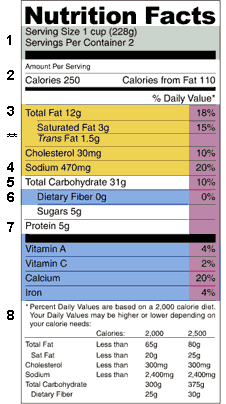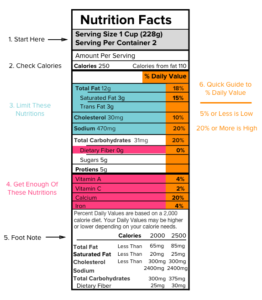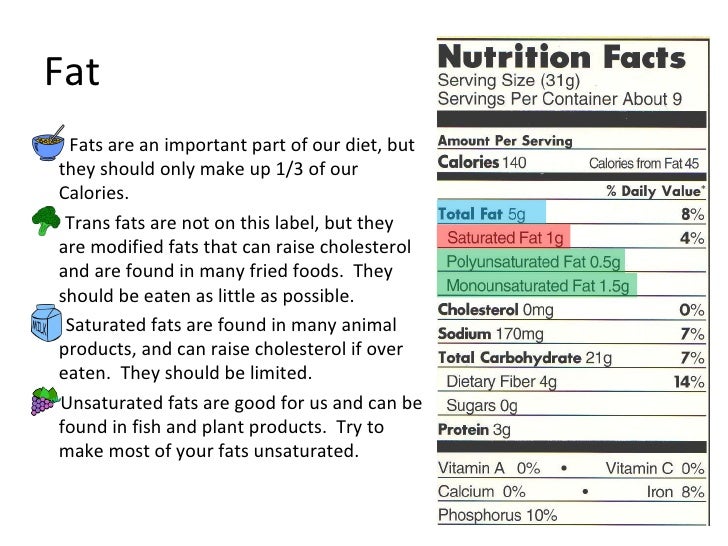43 reading fat on nutrition labels
How to read nutrition labels | safefood Nutrition information can be found on the back/side of food labels. Sometimes you will also find a snapshot of this information on the front of pack. Nutrition information is displayed per 100g and sometimes per recommended serving. Use the per 100g column to compare products. Look at the recommended portion size. How to read food labels: MedlinePlus Medical Encyclopedia If a food has less than 0.5 grams of saturated fat in the serving size on the label, the food maker can say it contains no saturated fat. Remember this if you eat more than 1 serving. You should also pay attention to trans fats on any food label. These fats raise "bad" cholesterol and lower your "good" cholesterol.
How to Read Nutrition Labels: Fat Content, Carbs & What To ... Nutrition labels are required to include total fat, saturated fat, and trans fat. The total amount of fat in the diet is a percentage of your calorie needs. The recommendation for the typical American diet is around 30%. For someone taking in 2,000 calories, this would mean around 70 grams of total fat per day.
Reading fat on nutrition labels
How To Read Nutrition Labels Like a Dietitian [Infographic] Nutrition labels are great; they help you figure out the ingredients and nutritional composition of a food product. Sometimes, though, they can be a bit deceitful. That snack may look healthy with only 6% of your daily saturated fat intake and 5% of your sodium, but take a closer look, and you realize that serving size is four crackers. Reading Food Labels | ADA - American Diabetes Association Reading Food Labels | ADA Understanding Food Labels It's time to decode those food claims. Trying to figure out nutritional information on labels and packaging isn't easy. The good news is that we can help. Untangle packaging claims. If you get tripped up on food content claims, you're not alone. Fat free vs. low fat vs. reduced fat. How To Read Food and Beverage Labels | National Institute ... Most older adults exceed the recommended limits for saturated fats, sodium, and added sugars. Compare and choose foods to get less than 100% DV of these each day, making sure to adjust for how many calories are in your diet. Additionally, many older adults do not get the recommended amounts of dietary fiber, vitamin D, calcium, and potassium.
Reading fat on nutrition labels. 3 Ways to Read Nutrition Facts on Food Labels - wikiHow Every number listed beneath "total fat" is calculated based on the amount contained in a single serving. So if the saturated fat on a label is listed at 6 grams but the number of servings is listed as 3, it means that there are a total of 18 grams of saturated fat in the container. [1] A Beginner's Guide to Reading Nutrition Labels | St ... A Beginner's Guide to Reading Nutrition Labels. Nutrition labels are great; they help you figure out the ingredients and nutritional composition of a food product. Sometimes, though, they can be a bit deceitful. That snack may look healthy with only 6% of your daily saturated fat intake and 5% of your sodium, but take a closer look, and you ... How to Understand and Use the Nutrition Facts Label | FDA Nutrients to get less of: Saturated Fat, Sodium, and Added Sugars. Saturated fat, sodium, and added sugars are nutrients listed on the label that may be associated with adverse health effects - and... PDF To Care 4 Yourself Reading a Nutrition Facts Label You can read the Nutrition Facts labels to compare calorie counts of similar foods to find the lowest-calorie option. Total fat This line tells you how much fat is in a serving of this food. It includes fats that are good for you, such as mono- and polyunsaturated fats.
How to Read Nutrition Facts Label | Food Network Healthy ... If you're eating 1600 calories, that equals about 17 grams of saturated fat per day. If you want to go with the American Heart Association's recommendations, that number will be 8.8 grams for the... How to read nutrition facts labels - Diabetes Care Community Find foods that will help you to increase or decrease your intake of a particular nutrient (for example, if you want to increase the amount of fibre, or decrease the amount saturated fat in your diet). 5 easy steps to reading a Nutrition Facts Table. 1.Look at the serving size. Compare the serving size on the package to the amount that you plan ... Fat Content on Food Labels - Reading Between the Lines ... The Mayo Foundation continued, "Still, you may be able to tell if a product contains trans fat, even if it's not directly listed on the food label. Look for the words ' hydrogenated ' or 'partially hydrogenated' in the list of ingredients. These terms indicate that the product contains trans fat. Nutrition Facts: How to Read Nutrition Labels The nutrition label lists total fat, saturated fat, and trans fat. It's the last two you want to focus on. Saturated fat is the kind you'll find in a burger, hot dog, or glass of whole milk.
How to Read a Nutrition Label - WebMD For those who understand its secrets, the nutrition label holds valuable information for winning the war on fat. Since there is no special ring, we'll give you the skinny on reading nutrition labels. Reading Nutrition Facts Labels | Magaram Center Nutrition ... When reading a nutrition label, you should always start by looking at the serving size first since all the information on the label is pertinent to that serving size. For example, if the serving size is 1/2 of the package and you eat the entire package, all those calories and grams of fat on the label would be doubled. The Basics of the Nutrition Facts Label A food item with a 5% DV of fat provides 5% of the total fat that a person who needs 2,000 calories a day should eat. You may need more or less than 2,000 calories per day. This means that you may need more or less than 100% DV that is listed on the package for some nutrients. Low is 5% or less. Reading Nutrition Facts Labels | Zuckerman Family Center ... Reading Nutrition Facts Labels. ... Get enough Fiber, Unsaturated Fat, Vitamin A, Vitamin C, Calcium and Iron in your diet. Vitamins A and C, Calcium and Iron aren't given by weight (in grams) but by % daily value. So for this product, in one serving, it contains 20% of the daily-recommended amount of Calcium and 2% of the daily-recommended ...
Reading Food Labels - aahs.org Reading food labels is key to choosing the right foods. Here are a few tips to keep in mind: Low-calorie foods have less than 40 calories per serving. Low-fat foods have less than 3 grams of fat per serving. (Read more about finding low-fat foods.) Low-cholesterol foods have less than 20 mg of cholesterol and 2 grams or less of saturated fat ...
How to Read a Nutrition Label - ThinkHealth Nutrients you want to limit include saturated fat, sodium and added sugars. Eating too much saturated fat and sodium may increase the risk of developing cardiovascular disease and high blood pressure. Total sugars include those naturally present in many nutritious foods and beverages, such as milk and fruit.
Understanding Food Nutrition Labels | American Heart ... When the Nutrition Facts label says a food contains "0 g" of trans fat, but includes "partially hydrogenated oil" in the ingredient list, it means the food contains some trans fat, but less than 0.5 grams per serving. So, if you eat more than one serving, you could end up eating too much trans fat.
How to Read Nutrition Facts Labels the Right Way - GoodRx Healthy fats can be a bit harder to find on a nutrition label. They are not required to be listed under "total fat," although some food manufacturers may voluntarily do so. Even if a product does not list these fats, you can identify them by becoming familiar with the sources of each type of fat. Sources of monounsaturated fats include: Nuts Seeds
PDF Reading Nutrition Labels - Xavier University Nutrition labels include actual amounts on top of the % Daily Value. Nutrition Labels 101 Serving size is the amount a typical eater consumes in a single sitting, not necessarily how much will meet an individual need. Serving size is important because all the information that follows is based on this amount. Fat is important for our diet
Food Labels: Fat & Cholesterol | Home & Garden Information ... The Nutrition Facts label shows you how much fat is in a product, even if the fat is hidden as an ingredient. The serving size and the nutrients listed on this label are consistent, which makes it easy to compare similar products without any calculations. % Daily Values (% DVs) are listed in a column on the "Nutrition Facts" label.
Interpreting Total Fat and Types of Fat on Food Labels ... Now, at the end of the day, since all high-fat foods tend to drive up calorie counts, it's typically recommended that you limit your intake of total fat to 25-35% of your daily calories. Of this amount, saturated fats and trans fats should comprise less than 7-10% and no more than 1%, respectively.
PDF A Guide to Reading Food Labels - University of Rochester Another important part of the label is the number of calories from fat. You should limit the number of calories from fat to 20-35% of your total daily calories. In the sample label, there are 250 calories in one serving and 110 calories from fat. This means almost 50% of the calories in a single serving of this food come from fat.
Quick Tips for Reading the Nutrition Facts Label To create your Tip Card: 1. Use a pair of scissors to cut along the dotted lines. 2. Fold along the center line. 3. Keep the Tip Card in your wallet or purse. Calories230 Amount per serving Serving...
How to Read Nutrition Labels Limit saturated fat, trans fat, sodium, and added sugars. They only increase your risk of heart disease, high blood pressure, cancer, and more. Instead, eat more dietary fiber, vitamin D, calcium, iron, potassium, protein, and select carbohydrates like whole-grain breads, rice, and vegetables.
How To Read Food and Beverage Labels | National Institute ... Most older adults exceed the recommended limits for saturated fats, sodium, and added sugars. Compare and choose foods to get less than 100% DV of these each day, making sure to adjust for how many calories are in your diet. Additionally, many older adults do not get the recommended amounts of dietary fiber, vitamin D, calcium, and potassium.
Reading Food Labels | ADA - American Diabetes Association Reading Food Labels | ADA Understanding Food Labels It's time to decode those food claims. Trying to figure out nutritional information on labels and packaging isn't easy. The good news is that we can help. Untangle packaging claims. If you get tripped up on food content claims, you're not alone. Fat free vs. low fat vs. reduced fat.
How To Read Nutrition Labels Like a Dietitian [Infographic] Nutrition labels are great; they help you figure out the ingredients and nutritional composition of a food product. Sometimes, though, they can be a bit deceitful. That snack may look healthy with only 6% of your daily saturated fat intake and 5% of your sodium, but take a closer look, and you realize that serving size is four crackers.











Post a Comment for "43 reading fat on nutrition labels"